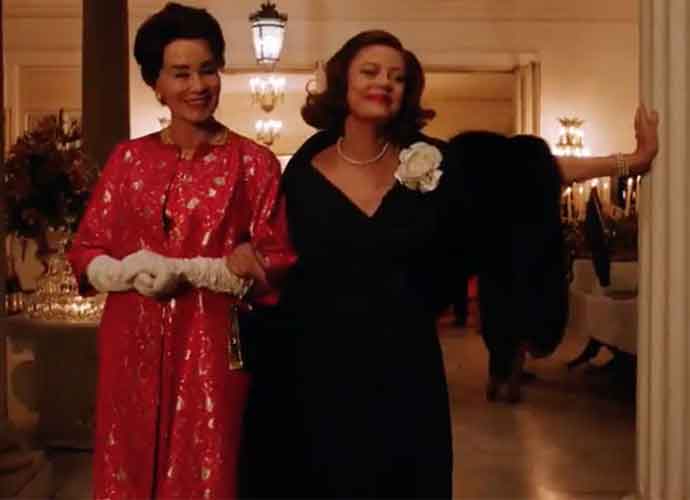‘Feud: Bette & Joan’ Finale Recap: The Rivalry Comes To A Close

4/5
Feud on FX came to an end on April 23, ending the rivalry between Bette Davis and Joan Crawford.
FEUD: BETTE AND JOAN FINALE RECAP
The final episode jumped between timelines, beginning in 1979 when Bob Aldrich’s assistant Pauline runs into Crawford at the airport, sitting in a wheelchair drunk and alone. “She seemed very much tossed away,” Pauline remembers. Then the show whisks up back to 1969 where we see Crawford heating up a microwave dinner for one. Mamcita comes to the door, and Crawford enjoys having her back, along with a new puppy named Lotus Blossom.
At the dentist’s office, however, we learn that the actress has six back molars removed years ago to give her a more attractive jawline – “the buckle,” it was called, a bloody reminder that beauty is pain in Hollywood. And now we see that the procedure left her with terrible issues, and the dentist wants to fit her with dentures. “I’d rather spit blood into a sink than look like Martha Raye,” is Crawford’s response.
Her agent calls and gives two lacklustre offers, which he clearly isn’t crazy about himself, but Crawford convinces herself of future glory and accepts both. The first, a B-movie film about a female anthropologist who discovers a preserved caveman; the second, a women’s lifestyle advice book.
While on set of the newly named Trog, it slowly appears to Crawford that this film is a bust, but she tries to be a team player anyway. She uses her downtime to work on her book. She realizes that alcohol is still the only thing keeping her happy, so she spends her nights drunk and wandering about the soundstage alone. At the same time, she dictates ideas for her book, which eventually comes in handy – when Joan Crawford: My Way of Life goes to print, a long line of fans show up for the singing.
Her shroud of happiness is singed off by an unflattering photo of herself in the newspaper, and she realizes that if that photo is who she’s become, then she must quit acting.
Finally we make our way to Bette Davis. We learn she’s been making pilots, none good, and none picked up. “Eight pilots she made,” says her friend Victor Buono. “It was like Miles Davis playing jingles for lunch meat commercials.”
Davis herself is upset that she can’t enjoy her twilight years, and blames Katherine Hepburn, who is still managing to pick up Oscar nods. “Am I not every bit her equal? How does she manage?” wonders Davis. And Buono replies, “Well, she sometimes says ‘no.’”
Davis meets her daughter for lunch, and the pair begin fighting within minutes. B.D. is mad at her mother for supposedly beating her son the night before while babysitting, and accuses her of being a drunk. Davis, meanwhile, isn’t doing herself any favors by drinking a margarita at 11 am. Though she acts defensive at the time, the next thing we know she is telling her doctor she is 17 days sober. Her sobriety is severely tested at the roast of Dean Martin, where Davis is “demeaned and insulted by fifth-rate celebrities.”
Following this, she decides to accept a role as the mother of evangelist Aimee Semple for the 1976 TV movie The Disappearance of Aimee, and finds herself working with even more terrible co-stars than Crawford.
Buono informs Davis that Crawford is holed up in her apartment very ill and insists she call. When Davis finally does, she says nothing to Crawford’s incessant “hellos” until she finally hangs up.
Now 1977, we learn that Crawford has become a Christian Scientist and is denying herself chemotherapy for her cancer. While her eldest daughter Christina is writing a book, Crawford is convinced it will slander her name and refuses to read. She gets assurance from her younger daughter Cathy, who says she was the best mom in the world, but it doesn’t make Crawford feel any better.
Crawford wakes up in a dizzying fantasy with Hedda Hopper and Jack Warner in her living room playing a game. In a bizarre conversation, the actress says, “I spent my whole life being Joan Crawford, a woman I created for others. I don’t know who I am when I’m by myself.” She also admits she wishes she’d been more generous with Davis, and a phantasm of her ex-rival appears and agrees. “It’s not too late, is it? We can start now,” says Crawford.
A week later, she is dead. Mamacita is upset that the people who show up for the funeral weren’t there when Crawford needed them most. A reporter calls Davis for a quote, which is how she finds out about the death. “My mother always said, ‘Don’t say anything bad about the dead. Only say good,’” she says. “Joan Crawford is dead. Good.”
Then it’s Davis’ time for her downfall. It starts with her receiving old letters from her mother, in which she relates a bratty, self-absorbed daughter. “I thought she was my only friend,” Davis says. “But actually I was totally alone.”
We flash back to the first day on set of Baby Jane and see an interaction between the titular characters. “Bette, here’s what I really hope for this picture when all is said and done,” says Crawford. “I hope I’ve made a new friend.” “Me too,” Davis replies.
And thus the eight-part series ends. We get postscripts telling viewers what happened to everyone remaining. Aldrich and Warner had a few more successes and died late in life known as “the last of the great movie moguls.” Buono died at 43 of a heart attack. B.D. became a born-again Christian and wrote a book about her mother that estranged them for the rest of their lives. Olivia de Havilland is 100 and still alive, living in Paris. Hedda died in 1966. And Davis was diagnosed with breast cancer, and underwent a mastectomy, but followed up with four strokes, leaving her left side paralyzed. She smokes as many as 100 cigarettes a day until her death in 1989. “She did it the hard way,” read her epitaph.
RELATED ARTICLES
Get the most-revealing celebrity conversations with the uInterview podcast!





Leave a comment